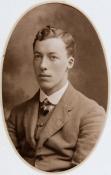
|
The King's School Canterbury |
Roll of Honour |
| Captain Edward Worrell CARRINGTON MC | |
|
Royal Army Medical Corps attached to the 2nd Battalion, Worcestershire Regiment Date of birth: 13th December 1888 Date of death: 27th September 1915 Killed in action aged 26 Buried at Vermelles British Cemetery, Plot I Row F Grave 34. |

|
| He was born at Oxford on the 13th of December 1888 the youngest son of Sir John Worrell Carrington, Chief Justice of Hong Kong, and Lady Susan Catherine (nee Walsh) of Avenue House, Western Elms Avenue, Reading in Berkshire. He attended the Junior King's School from May 1896 to July 1902 following which he went on to Marlborough College where he was in B1 House from September 1902 to July 1907 and was appointed as a Prefect in his last year. In July 1907 he won a Science Exhibition to Keble College Oxford and began studying medicine there on the 14th of October 1907. He was awarded a Scholarship in March 1908. He gained a 1st Class Degree in Natural Sciences (Physiology) in 1911 and a MA in 1915. He was a member of the Oxford University Officer Training Corps. He went on to King's College Hospital on an Open Scholarship to study medicine in 1912, becoming MRCS (Eng) and LRCP (Lond) in 1913 and being entered on to the Medical Register on the 3rd of November 1913. While he was at King's College he won the Tanner Prize in obstetrics, the Todd Prize and Medal for general proficiency. He worked as resident physician at the King Edward VII Memorial Hospital at Ealing and returned to King's College Hospital in 1914 as Assistant House Surgeon to Professor A. Carless. He was commissioned as a Temporary Lieutenant the Royal Army Medical Corps on the 10th of August 1914 and was sent to the front shortly afterwards, disembarking in France on the 19th of August. On the 20th of October 1914, Captain Rupert Henry Nolan RAMC, the Medical Officer of the 2nd Battalion Worcestershire Regiment was killed in action and Edward Carrington joined the battalion at Ypres as his replacement. He was awarded the Military Cross which was reported in the London Gazette of the 18th of February 1915 for attending to the wounded under heavy shell fire at Ypres on the 31st of October 1914 when the battalion was involved in a counter attack at Gheluvelt Chateau. He was promoted to Captain on the 11th of August 1915. On the 27th of September 1915 the 2nd Battalion Worcestershire Regiment was in support of 7th Division, who had been driven from their position at the 'Quarries' during the night of the 26th/27th by a German counter attack. The plan for the 27th was for 7th Division to retake the Quarries and for the 2nd Worcesters to pass through them and take the German positions at Cite St Elie. For most of the day the battalion waited in drizzling rain before any orders were received. News came though that 7th Division's attack had failed and the Worcesters were given the order to attack the Quarries themselves. At 1pm they filed into communication trenches at Vermelles but progress up the trench was hampered by the equipment they were carrying and by crowds of wounded men lying in the trench. By 4.45pm they had arrived behind the British front line trenches and deployed for their assault. With bayonets fixed they went over the top and came under heavy fire as they reached the British front line which was choked with dead and wounded from 7th Division's attack. The men of the Worcesters piled into the trench. Colonel Lambton, Major Wainwright and Medical Officer, Edward Carrington, walked coolly up and down the parapet re-organising the troops for the assault. The attack began again and the advancing Worcesters were met by a hail of rifle and machine gun fire with officers and men cut down in rows. The survivors found a half dug trench 200 yards from the German front line and they flung themselves down and fired volley upon volley towards the German line. As the very few remaining officers were about to rally the men for a final bayonet charge a Staff Officer called a halt to any further advance. The men held their position until nightfall and consolidated the new line during the night. The battalion had lost thirteen officers, including all four company commanders, the Machine Gun Officer and their Medical Officer Edward Carrington along with more than three hundred other ranks. He was mentioned in Sir John French's despatches of the 14th of January 1915 and in his despatches of the 30th of November 1915. His Colonel wrote: - "If any man ever gave his life for others it was he. He was one of the bravest men I ever saw." He is commemorated on the war memorial at King's College London, on the memorial at Marlborough College and on the memorial at Keble College Oxford. |
|
| Junior King's School |
Back